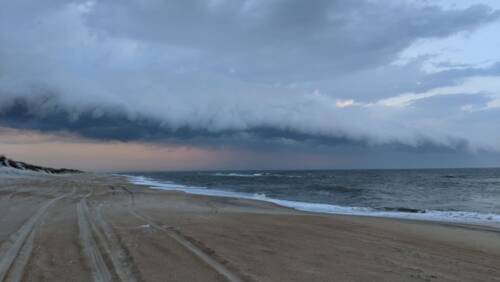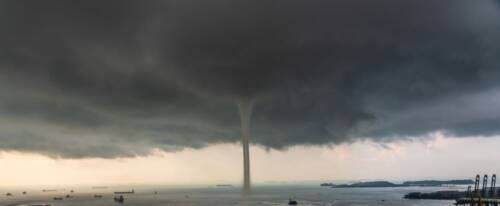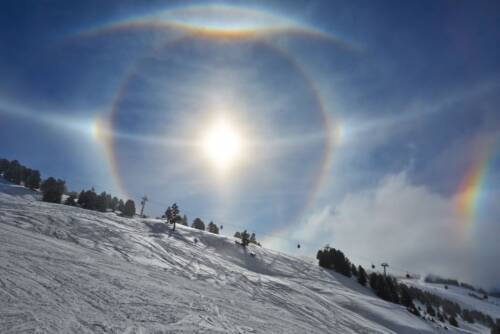Strange Weather Phenomena Part 2
From the ferocious roar of thunderstorms to the mesmerizing sight of volcanic lightning, our world is adorned with some truly remarkable and peculiar weather events. With this in mind, we are continuing our series on strange and rare weather phenomena. Exploring and staying aware of these natural marvels not only unveils the beauty of our planet’s intricacies but also is essential for business leaders. These events can significantly impact business operations, posing challenges and opportunities across different industries.
Squall Lines: The Mighty Roar of Thunderstorms
Thunderstorms can develop in various forms, sometimes taking shape in a formidable line known as a squall line. These ominous formations typically result from a cold front’s push, creating ideal conditions for thunderstorm development over a widespread area. These lines of storms often feature strong, straight winds, heavy rainfall, hail, lightning, and occasionally, tornadoes.
A particularly strong squall line is known as a derecho. This monstrous storm, with its bow-shaped appearance, is characterized by wind speeds exceeding 58 mph and a trail of destruction over an expanse of at least 250 miles, reminiscent of tornado-like devastation but in a straight-line trajectory.

Squall lines and derechos can have detrimental implications for various business sectors. Severe thunderstorms and derechos can lead to flight cancellations, road closures, and interruptions in shipping and freight services. This can delay deliveries, affect supply chains, and increase transportation costs. High winds, hail, and lightning from these storms can damage buildings, power lines, and other infrastructure. Businesses might face repair costs and downtime due to power outages or structural damage. Businesses relying on outdoor operations or services might face disruptions. For instance, outdoor events, construction projects, or agriculture activities can be severely impacted, leading to financial losses.
Waterspouts: Nature’s Tornadoes at Sea
Waterspouts, resembling tornadoes made of water, create a mesmerizing yet captivating sight. These phenomena can originate from tornadoes transitioning from land to water or can form in fair weather conditions over open water. Warm temperatures and high humidity cause localized air to rise vigorously, creating a funnel that draws up water, typically resulting in low-intensity tornadoes (EF0) that last for brief periods.
An intriguing aspect of waterspouts is their knack for lifting marine life from water surfaces and depositing them over land, contributing to anecdotes of raining fish or frogs caused by these watery whirlwinds.

Unsurprisingly these strange aquatic tornadoes can be of concern to coastal industries and tourism. Businesses involved in maritime activities, such as shipping, fishing, and tourism, may experience disruptions due to waterspouts. Fishing operations might need to halt, and marine transportation schedules could be affected. Businesses in coastal regions may face temporary closures or reduced visitors due to safety concerns.
Volcanic Lightning: Nature’s Electric Display
Volcanic eruptions, with their explosive force and ash-laden clouds, often produce an astonishing display of lightning. Unlike typical thunderstorms where ice particles generate electric charges, volcanic lightning occurs due to the friction between airborne volcanic fragments. The extreme heat and danger associated with volcanic eruptions make studying this phenomenon challenging. However, the heat generated by volcanic lightning can melt ash, solidifying into tiny glass spheres, providing insights into the intensity and duration of these lightning strikes.

While volcanic eruptions and their resulting lightening are not top of mind concerns for most of us, especially in the United States, these events still impact different industries. Volcanic eruptions can cause flight cancellations or diversions due to ash clouds and associated lightning. Tourism in affected areas might decline, impacting hotels, restaurants, and local businesses. Ash fallout from volcanic eruptions can harm crops, affect livestock, and damage ecosystems. Agricultural businesses may experience reduced yields, leading to economic losses.
22° Halo: The Enigmatic Rings in the Sky
Halos, the ethereal rings encircling the sun or moon, have intrigued observers for centuries. These phenomena often precede rain or snow, though they do not guarantee imminent precipitation. Halos owe their existence to wispy clouds composed of ice crystals, situated high in the atmosphere. When light encounters these ice crystals, they act as prisms, separating light into its constituent colors and creating the halo effect. The angle at which one observes this phenomenon dictates its appearance, with the halo spanning approximately 22°—roughly the width of a handspan held at arm’s length.

Halos themselves might not directly impact business operations, but their association with impending weather changes might influence consumer behavior. For instance, grocery stores may experience increased sales before anticipated rain or snow. Additionally, businesses organizing outdoor events or activities might need to adapt plans based on the presence of halos and potential weather changes. This could impact attendance and revenue generation.
Stay Aware of the Risks and Opportunities
Nature’s repertoire of strange weather phenomena continues to captivate us. Understanding the science behind these events not only deepens our appreciation for the wonders of the natural world but also provides invaluable insights into the risks or opportunities associated with these weather patterns. In response to these weather phenomena, businesses across industries often employ risk management strategies, such as insurance coverage, contingency planning, diversification of suppliers or markets, and utilizing weather forecasting services to mitigate potential impacts on operations. However, some businesses might capitalize on weather-related opportunities such as increased demand for storm-proofing services or emergency repair services during severe weather events. If you’d like to learn how Climavision’s advancements weather insights can better help you and your organization stay aware and prepared, contact us.




